Novak Djokovic saves two match points in epic Wimbledon final victory over Roger Federer
In a classic, Federer was ahead in almost every statistical measure … except the one that counted.
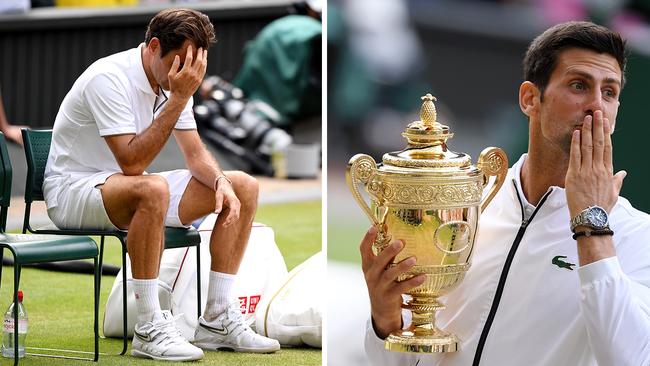
Displaying resilience almost beyond belief, Novak Djokovic has created history at Wimbledon by defeating Roger Federer in one of the greatest finals ever played.
The world No 1 claimed Wimbledon’s first deciding tie-breaker when successful 7-6 (5) 1-6 7-6 (4) 4-6 13-12 (3) in 4hr 57min, which made it the longest final ever played at Wimbledon.
MORE: Epic final Djokovic’s ‘most demanding win’
It may well prove the most important match in history given the tightness of the race between Federer, Rafael Nadal and Djokovic in regards to the all-time grand slam honour roll.
And if Djokovic eventually becomes the most successful, it will be fitting that a compelling epic was part of his journey.
In claiming a fifth Wimbledon crown — and defending one for the second time — the Serbian became the first player since Bob Falkenburg in 1948 at this tournament to defend match points in the final and win. Gaston Gaudia was the most recent player to do so at grand slam level when triumphant in Paris in 2004.
A match for the ages…
— Wimbledon (@Wimbledon) July 14, 2019
The moment @DjokerNole retained his crown to become #Wimbledon champion for a fifth time after a historic men’s singles final#JoinTheStory pic.twitter.com/zDQlEBviMD
The 32-year-old did so when, with Federer serving with two match points at 8-7 in the fifth set, he was able to defy the 20-time major champion, with a whipped forehand winner on the second remarkable in the circumstances.
Djokovic described it best when stating that in a match like this, it is unfortunate for there to be a loser. And Federer can truly claim to be unlucky, having been edged in all three tiebreakers played. The 37-year-old claimed the second and fourth sets with aplomb and actually won 14 more points than his rival.
Indeed, the father-of-four was ahead in almost every statistical measure bar the one that truly counted.
Federer remains at the head of the all-time list with 20 titles. Nadal is second with 18. And Djokovic is closing rapidly, with this his 16th triumph. The trio are true legends.
Djokovic showed true mental fortitude when it counted most in the tiebreakers, when down match points and also when handling a heavily partisan crowd clearly supporting Federer.
It was a particularly special victory, he said.
"When I was a boy... I used to make the trophies out of different materials in my room"@DjokerNole's childhood dream has become a reality for a fifth time...#Wimbledon pic.twitter.com/fpRYRIE9BA
— Wimbledon (@Wimbledon) July 14, 2019
“Unfortunately in these kinds of matches, one of the players has to lose,” he said.
“It is quite unreal to be two match points down and be able to come back to win.
“Roger said that he hopes he gives some other people a chance to believe they can do it at 37. I am one of them.
“I know I have said this before, but when I was a boy … dreaming to be one a tennis player one day, this had always been the tournament for me.
“It is extra special sharing it with my son in the crowd and my parents.”
Federer did have his chances in what was a phenomenal performance. It is incredible to win at least six games in every set and still be beaten.
He was defeated on court, certainly, but his fighting characteristics were again demonstrated in marvellous fashion.
“At 37, it’s not over yet!"
— Wimbledon (@Wimbledon) July 14, 2019
For @rogerfederer, the pursuit of more Grand Slam glory continues...#Wimbledon pic.twitter.com/Y1o1b1tjf4
“I will try to forget,” Federer joked when asked about being part of a historical match.
“It was a great match. It was long. It had everything. I thought we played some great tennis. In a way, I have to be happy with my performance as well.
“But Novak, congratulations. You were great.”
To think Federer turns 38 next month is remarkable given the calibre of tennis he is playing.
“I hope I give some other people the chance to believe that at 37 it is not over yet,” he said.
“I couldn’t give more. I gave it all I had. I feel good. I still stand.”
There were an array of twists and turns en route to this becoming a match for the history books.
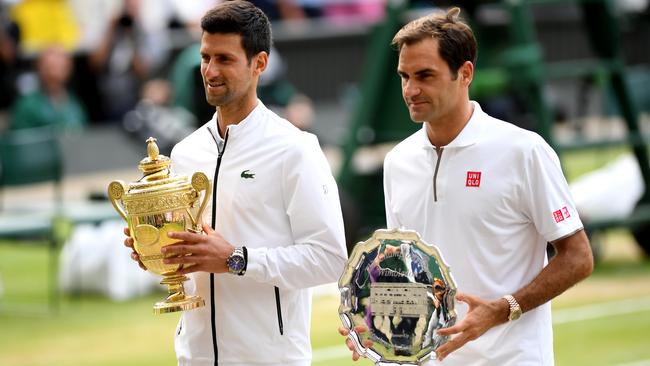
It was a service hold to love by Federer that forced the first ever deciding tie-breaker in a singles match at the club, with the rule introduced for this year’s championships and history at Wimbledon was made.
Djokovic, truly, produced clutch performances in all three tiebreakers he claimed and the decider was no different. In claiming it 7-3, he made just the one error and that was effectively forced upon him.
In turn, he was able to apply the pressure to the Swiss, who erred on three critical points — all due to the quality of the play by the Australian Open king.
A precise and powerful double-handed backhand thumped down the line gave him three match points and the title was his when Federer framed a forehand into the crowd.
The path there was brilliant, full of theatre and tension.
Federer started sharply. His first strike was an ace. And he served another to open with a strong service hold.
And the defending champion returned the favour by holding to love. There were no signs of nerves, which is scarcely a surprise given the number of times the sportsmen had stepped on to centre court.
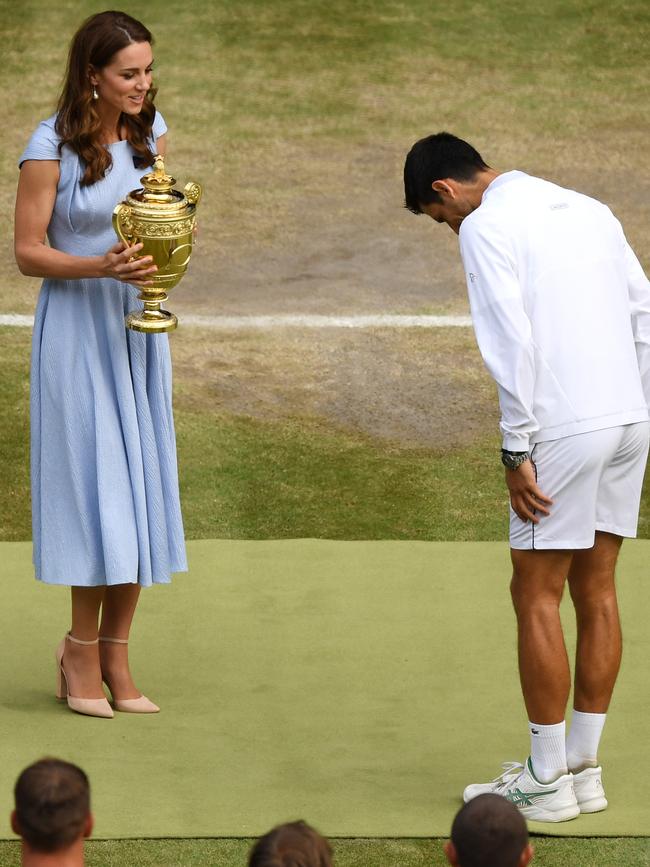
The Swiss had a chance to seize an initial break when leading 2-1 but missed with an off-forehand drive.
But already an initial tactic was apparent.
The Swiss was slicing short, with angle if possible, to the Djokovic double-handed backhand which provided an opportunity, but one that went begging.
Mindful of how masterful the world No 1 is from the baseline, Federer clearly believed he needed to drag him forward or at least make him hit with some caution.
The eight-time champion serve-and-volleyed for the first time at 3-all, 40-0, making a crisp backhand volley and then an angle forehand.
Djokovic was superior in groundstroke rallies early, almost computer-like in his ability to land shots deeply with precision and weight.
Similarly to Friday’s semi-final between Federer and Nadal, this was a match up resplendent for the contrast in style and approach.
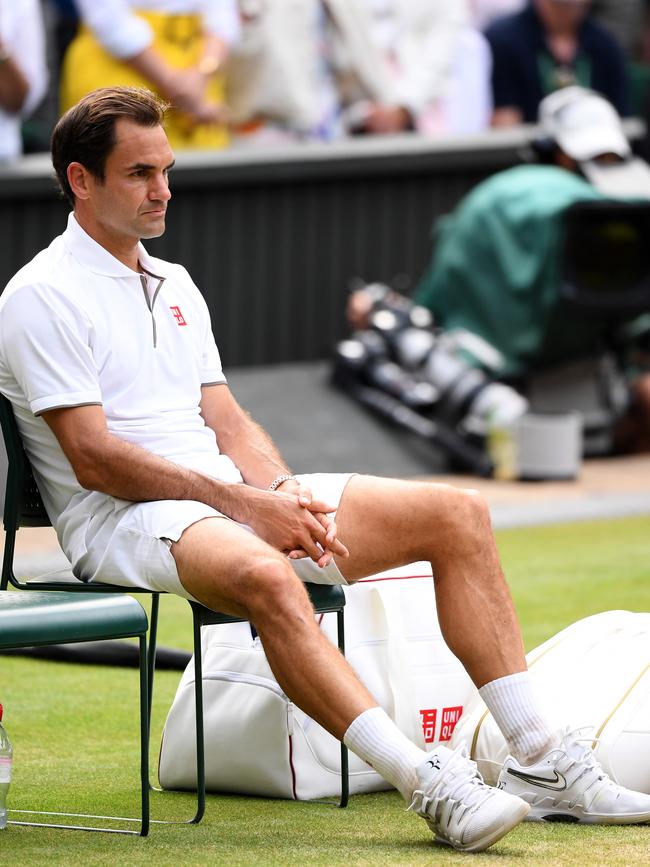
At 5-4 on the Serbian’s serve, the 37-year-old loved to 0-30 with two superb off-forehand drop shots.
Djokovic responded. His first serve percentage for the set was not particularly high but he landed strong serves on critical points.
It was a tense, tough set. From testing positions, the champions won their way out of trouble through sublime shot making. A gifted point was especially rare.
After 49 minutes, a tie-breaker was needed to decide the first set.
Federer has his chances early on the Djokovic serve. A forehand crosscourt pass to the open court at 1-all, which appeared a regulation winner, ballooned long and could have proved costly.
The Swiss responded with two brilliant winners in succession to seize a mini-break. But then two forehand errors in succession — which brought his tally to four for the tie-breaker — gave the defending champion the ascendancy and he was able to clinch the opening set when Federer erred on the backhand.
After such a tense set, it was scarcely surprising that one of the players suffered a let down early in the second. And it was Djokovic who dipped first, dropping serve immediately with several errors.
And when the blaster from Basel ripped an off-forehand winner two games later, he held a double-break at 3-0.
There was a parallel to Federer’s triumph over Nadal on Friday. After clinching a tense tie-breaker to claim the first set against the Spaniard, it was the Swiss whose concentration broke in a remarkably swift second set.
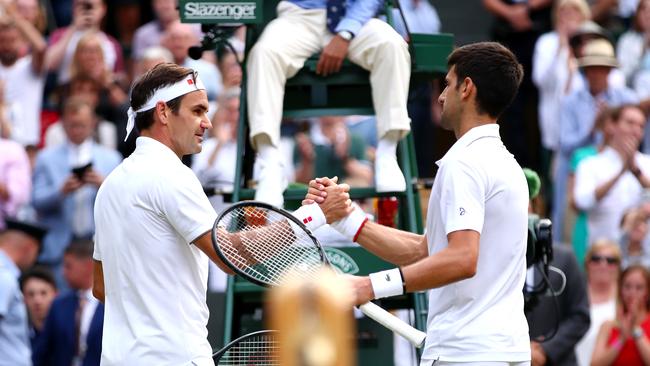
A double-fault struck, it appeared, deliberately given the distance it missed by Djokovic when trailing 1-5, 0-40 and the final was square again, with a best-of-three sets left for one man to secure the championship. It was the most lopsided set against Djokovic claimed by Federer in seven years.
Even the score line was the same. 7-6 1-6. Against Nadal, Federer regrouped in magnificent fashion in the last two sets but it surely must have served as an example of the importance of maintaining concentration for both men.
The Swiss remained phenomenally focused on serve. He had the best return in tennis completely flummoxed when it came to finding a solution to his serve. But Djokovic regained his usual discipline as well on serve as the third set edged towards another nailbiting conclusion.
Federer’s numbers were better in almost every statistical category, yet nothing separated them on the only measurement that ultimately counts, namely the scoreboard.
But then, with the score at 1-set all, 5-4 to Federer, he produced a majestic half-volley to bring up a set point. Djokovic responded a heavy first serves directed at the body to level again as the decider passed the two hour mark.
Come the tie-breaker, the Swiss shanked a backhand on the opening point to give the Serb an early advantage. The forehand betrayed Federer in the first tie-breaker and this time it was the backhand that deserted him, with the 37-year-old making three early errors on the wing to trail 1-4.
Federer did not face a single break point in the opening three sets. Yet he trailed two sets to one.
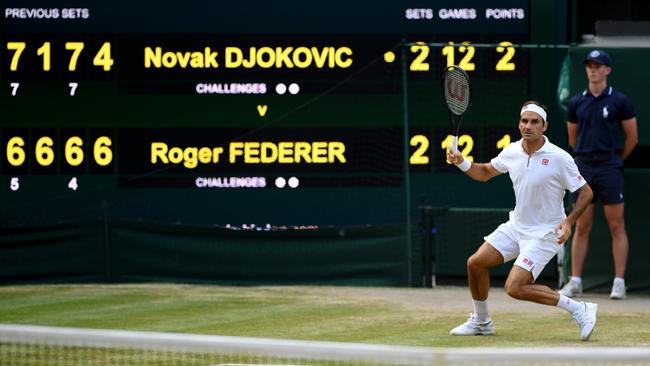
In many regards, that is a complement to the championship quality of Djokovic, who was able to deliver when the pressure was at its peak in the tiebreakers.
Tennis has always been a game where a millimetre, or a solitary point, can be the difference between triumph and despair.
A Federer slice backhand down the line, off pace and with enough spin to make it awkward for his rival, narrowly missed at 4-5 in the third set tie-breaker.
Then, in the fifth game of the fourth set, Djokovic thundered a forehand at 15-30, 2-all in the fourth set that was called in. A challenge showed it had missed by a millimetre. And if there has been a louder roar in centre court at Wimbledon, prompted by the realisation Federer had an opportunity to pounce, it must have been some occasion.
And pounce the Swiss did, breaking the Djokovic serve and following it up two games later as he raced to a 5-2 lead in the fourth set.
The Serbian, finally, earned a break point in that game. And the point with which Federer saved it was a truly remarkable rally lasting 35 points ended by a backhand winner from the elder man.
Another opportunity followed and finally, 2hr 49min into the decider, Djokovic managed to break serve. And that was only to stay alive in the set.
When the 2017 champion cracked a driven forehand volley to close out the set to love, an intriguing final reached a deciding set.
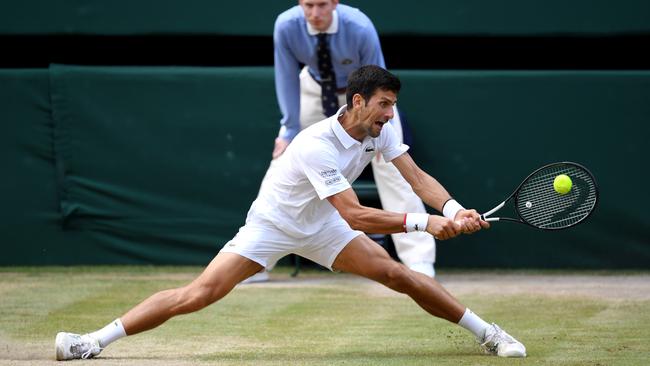
It was a one-set shoot out for the crown. With the match time at three hours exactly, the world No 1 stepped out to start the stoush for the greatest prize in tennis against the second seed.
The momentum favoured Federer, but the history suggested Djokovic given he had claimed their three prior matches to go the distance.
The deciding set threatened to become a tale of the tape early. With Federer serving at 1-2, Djokovic claimed the opening point off a dead let chord. At 15-30, what would have been a Federer ace caressed the chord. On the re-play, the Swiss looked to have his rival beaten with a forehand pass crosscourt, only for it to flick the tape and fly wide. Yet somehow the legend found a way out of trouble, digging remarkably deep to save three break points and level for 2-all.
After 41 games and two tiebreakers, it appeared the Serbian has finally found his remarkable return with a string of quality shots placing Federer under immense pressure.
And when he whipped a backhand crosscourt backhand past the lunging legend, Djokovic appeared to have seized the critical break in the match.
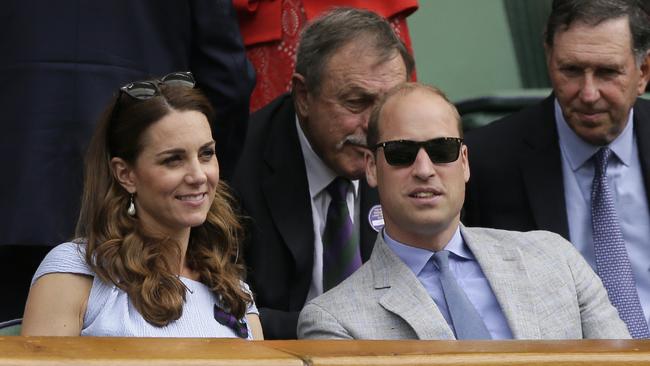
A double-break at 30-all in the following game gave Federer the chance to respond, but the Swiss overshot a forehand in a regulation rally.
The enormity of the occasion seemed finally to be weighing on both men. But a Federer forehand winner and a Djokovic error and the match was again back on level billing.
The back and forth drew an energised response from the crowd rarely, if ever, seen in tennis. At the change of ends, a chant of “Let’s GO Roger, Let’s GO” echoed around the centre court.
Djokovic made an astonishing diving volley at 5-all, 15-30, falling to the ground to claim an important point.
At 30-40, 7-all, he thumped a serve wise to the backhand, but Federer got just enough on the ball to float it back.
The Serbian went crosscourt to the forehand.
Federer was moving there in unison, prepared for his moment to strike. Bang. A forehand ripped across the path of the incoming champion. The break.
And with it, Federer had the chance to serve out perhaps the biggest win of the grandest career. But he faltered.
*How* do you do this to save Championship point?#Wimbledon @Djokernole pic.twitter.com/cHPpqADVFG
— Wimbledon (@Wimbledon) July 14, 2019
He shanked a forehand long on the first point. He shanked one in the next, but this one dipped in and drew an error.
An ace followed. And then another. Two championship points. But Djokovic defended again, zooming back to deuce with a forehand winner — a truly remarkable effort given the occasion — and then moving to break point.
And when Federer netted a forehand, it was eight-all.
The crowd was heavily behind Federer to the extent it was almost disconcerting.




To join the conversation, please log in. Don't have an account? Register
Join the conversation, you are commenting as Logout